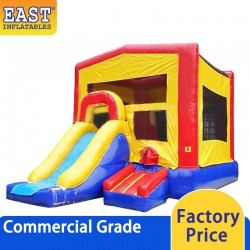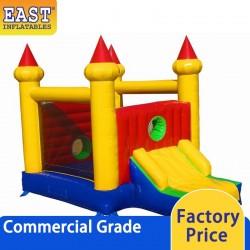
Anchoring a bouncy castle is essential to ensure the safety of the children playing on it. Bouncy castles are inflatable structures that can be prone to movement or tipping, especially in windy conditions. Properly securing the bouncy castle will help prevent accidents and injuries. Here's a step-by-step guide on how to anchor a bouncy castle:
1. Choose a Suitable Location
Select a flat and level area to set up the bouncy castle. Avoid placing it on slopes, uneven surfaces, or near obstacles like trees, fences, or walls. A clear, open space ensures that the inflatable can be securely anchored and used safely.
2. Gather the Right Equipment
You'll need suitable anchoring equipment, which usually includes heavy-duty metal stakes or pegs and strong ropes or straps. Some bouncy castles may come with anchor kits, so make sure to check the package. The type and number of anchors required may vary based on the size and design of the inflatable.
3. Inspect the Bouncy Castle
Before setting it up, check the bouncy castle for any damages or punctures. Ensure it's in good condition and has no leaks. Proper maintenance and regular inspections help ensure the safety and longevity of the inflatable.
4. Secure the Anchor Points
Locate the designated anchor points on the bouncy castle, usually reinforced areas around the base. Insert the metal stakes or pegs through these anchor points and drive them securely into the ground. If you're using sandbags or water weights, place them over the anchor points as per the manufacturer's instructions.
5. Attach Ropes or Straps
Connect the ropes or straps to the anchor points on the bouncy castle. Ensure they are tight and securely fastened to prevent movement. Adjust the tension to keep the inflatable stable and in place. Avoid any slack in the ropes to ensure maximum stability.
6. Check Stability
After anchoring the bouncy castle, gently test its stability by applying some pressure or by having a small number of people bounce on it. Ensure it remains firmly in place and does not shift or tip. Make any necessary adjustments to the anchors or straps if needed.
7. Monitor During Use
Continuously monitor the bouncy castle during use, especially in windy conditions. Regularly check the anchors and straps to ensure they remain secure and adjust them as necessary to maintain stability.
8. Deflate and Remove Anchors
When the bouncy castle is no longer in use, turn off the air blower and begin deflating the inflatable. Once it is fully deflated, carefully remove the anchors and ropes or straps. Store them properly along with the bouncy castle to avoid damage or loss.
Conclusion
Properly anchoring a bouncy castle is crucial for ensuring the safety of its users and the longevity of the equipment. By following these steps, you can secure the inflatable effectively and provide a safe environment for children to enjoy.




Leave a Comment